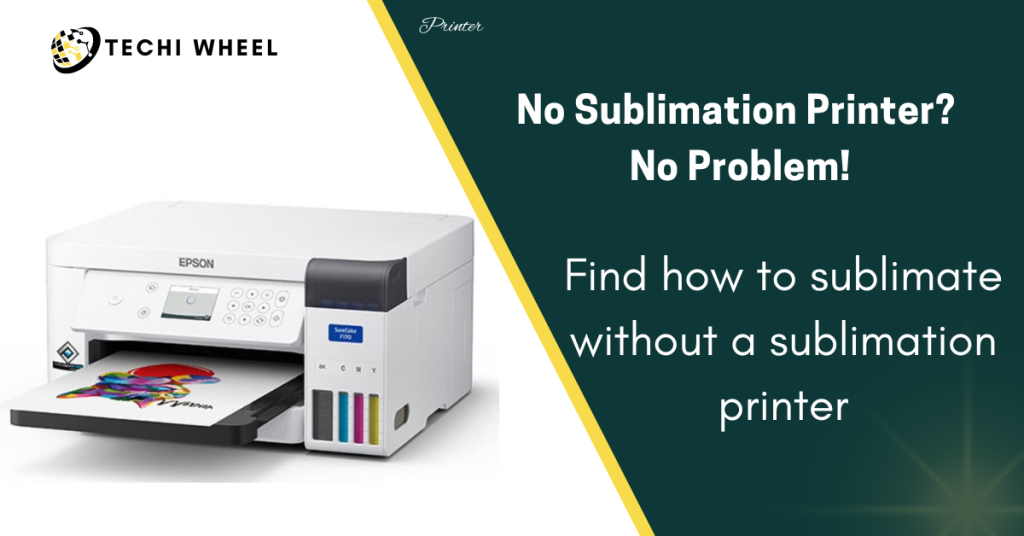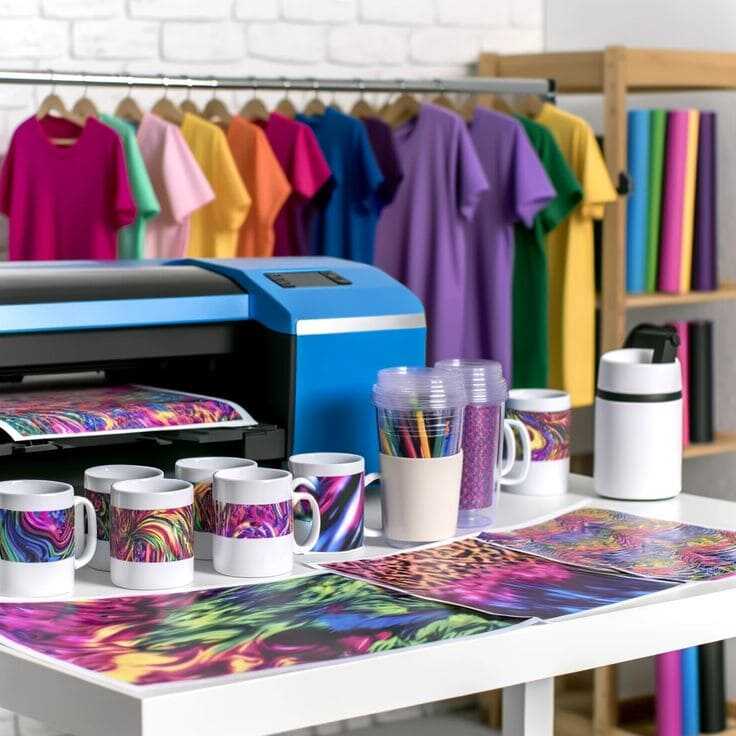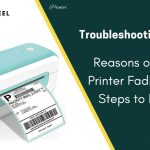The sublimation printing process transfers high-quality images onto a variety of materials, including fabrics, ceramics, and metals. However, sublimation printing can be accomplished without a sublimation printer, although it’s often associated with them.
This article explores how to sublimate without a sublimation printer?,tips for sublimation printing to get best sublimation results, what equipment do you need for sublimation printing?.

Using innovative techniques and alternative tools, you can harness the potential of sublimation printing without a dedicated printer. Explore the possibilities in this comprehensive guide.
What Equipment Is Needed For Sublimation Printing?
- Paper
- Sublimation ink
- Heat press
- Sublimation blanks
- Safety equipment
- Sublimation printer
Also Read:Do You Need a Label Printer for Your Small Business?
Equipments Needed for Sublimation Printing
Let’s go over the materials and equipments needed to sublimate without a sublimation printer:
- Paper:During printing, transfer paper has a heat-sensitive layer that holds the ink until it dries.
- Sublimation ink:The ink used in sublimation printing is called sublimation ink. Sublimation ink is important for sublimation printing because it is heat activated and will create vibrant colors.
- Heat press:The heat press transfers ink from the transfer paper to the material being printed using heat and pressure. For high-quality sublimated prints, you need a good heat press.
- Sublimation blanks: These are the materials that will be printed on. Items such as ceramic mugs, t-shirts, or phone cases can be used as blanks.
- Safety equipment:Heat-resistant gloves and tape to protect you from burns and to secure the printed paper to the fabric
- Sublimation printer:A specialized inkjet printer that uses special sublimation ink. Regular printer ink won’t work.

How To Do Sublimation Without A Sublimation Printer?
Steps for Sublimating without a Sublimation Printer
Now that we’ve covered the materials and tools needed, let’s go over the steps for sublimating without a sublimation printer:
Step 1: Choose the image you want to print
The first step is to choose the image you want to print onto your blank. This can be a photograph, a design you’ve created, or a piece of artwork.
Step 2: Print the image onto transfer paper
Next, you’ll need to print the image onto transfer paper using an inkjet printer. It’s important to note that the inkjet printer should be dedicated to sublimation printing as using regular ink can damage the printer.
When printing onto transfer paper, be sure to mirror the image so that it is backwards on the paper. This is important as the image will be flipped when it is transferred onto the blank.
Step 3: Cut out the image
Once the image has been printed onto the transfer paper, cut it out using a pair of scissors or a cutting machine.
Step 4: Preheat the blank
Preheat the blank using the heat press to remove any moisture and prepare it for the transfer process. Be sure to check the temperature and time settings for the specific type of material you’re using.
Step 5: Place the transfer paper onto the blank
Place the transfer paper onto the blank, making sure it is centered and aligned properly.
Step 6: Press the transfer paper onto the blank
Use the heat press to press the transfer paper onto the blank. Be sure to follow the temperature and time settings for the specific type of material you’re using.
Step 7: Remove the transfer paper
Once the transfer paper has been pressed onto the blank, carefully remove the transfer paper. You should be left with a vibrant, sublimated print.
Also Read: How to Prevent and Fix Fading on Your Thermal Printer?
How do I get the best sublimation results?
Tips for sublimation printing
Here are some tips to help you get the best sublimation results when sublimating without a sublimation printer:
- Transfer paper for sublimation:Sublimated prints can be improved by using high-quality transfer paper.
- Material:While sublimation printing is often associated with fabrics, it can also be applied to ceramics, metals, and other materials. Find out what works best for you by experimenting with different materials.
- Try different heat and pressure settings: The heat and pressure settings will vary depending on the material used. Make sure to test different settings to find out what works best for your material.
- Use a Teflon sheet: Placing a Teflon sheet over the transfer paper and blank can help prevent any ink from bleeding onto the heat press or the material.
- Heat-Resistant Tape:Attach your sublimation paper to your blank with heat-resistant tape. This stops any motion during the transfer procedure, which may result in ghosting or blurriness of the image.
- Observe How Others Do It:It is well-known that individuals often develop their unique methods for sublimating an item, but it’s equally beneficial to stay updated with recent videos and blogs about the latest trends in sublimation or techniques for pressing an item. In that process, you might discover something simpler or achieve a better transfer than what you typically do. Alternatively, if you are completely new, a bit of research can be very beneficial.
- Avoid using dark-colored materials: Sublimation printing works best on white or light-colored materials. Using dark colors can cause them to appear dull and muted.

What Is Classic Dye Sublimation Prints?
A “classic dye sublimation print” describes a premium print produced via the dye sublimation method, in which a digital image is applied to a medium such as fabric or metal by turning special dye inks into a gas through heat, leading to vivid, lasting colors deeply integrated into the material.
Comment below, share this with friends, and visit our site Teechiwheel for more Printers ,Laptop,Tech related updates!
Conclusion
On a variety of materials, sublimation printing is a versatile and popular printing method. Sublimation printing is often associated with sublimation printers, but it is possible to achieve it without one. The steps outlined above can be followed and the right materials and tools can be used to achieve high-quality sublimated prints. To find out what works best for you, experiment with different materials and settings, and have fun!
FAQs:
Can you use sublimation ink for regular printing?
No, sublimation ink is not suitable for regular printing. Sublimation ink is designed for specialized sublimation printers and heat transfer processes, where the ink converts into gas and bonds with materials like polyester or coated surfaces. Regular printing requires standard inkjet or laser printer inks.
Do you need a sublimation printer to use sublimation paper?
Yes, you need a sublimation printer to use sublimation paper effectively, as the printer uses sublimation ink to transfer designs onto materials.
Can you sublimate with a regular printer?
No, you cannot sublimate with a regular printer. Sublimation requires a specialized printer designed for sublimation inks, which are different from standard inks used in regular printers.
Can you print white with sublimation?
No, you cannot print white with sublimation because sublimation inks are transparent and rely on a white or light-coloured surface. For white areas, a specialised white substrate or vinyl is needed.
Can you convert a printer to sublimation after using regular ink?
No, you cannot convert a printer to sublimation after using regular ink unless the printer is thoroughly cleaned of all traces of regular ink. Even then, success isn’t guaranteed, and specialized sublimation printers or printers designed for conversion (e.g., specific Epson models with piezoelectric printheads) are typically recommended.
How much to charge for sublimation prints?
Charge $3–$5 per print for smaller designs like mugs or keychains. For larger items like T-shirts, charge $8–$15 per print, considering material and complexity.


